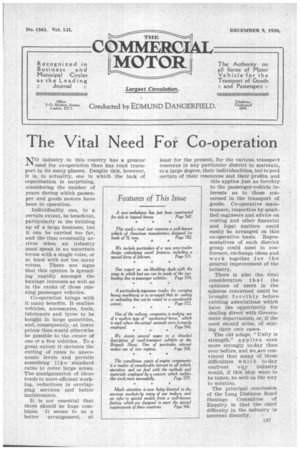The Vital Need For Co-operation
Page 35

Page 36

If you've noticed an error in this article please click here to report it so we can fix it.
NO industry in this country has a greater need for co-operation than has road transport in its many phases. Despite this, however, It is, In actuality, one in which the lack of organization is surprising, Individuality can, to a certain extent, be beneficial, particularly in the building up of a large business, but it can be carried too far, and the time eventually arrives when an industry must speak in no uncertain terms with a single voice, or at least with not too many voices. There are signs that this opinion is spreading rapidly amongst the haulage interests as well as in the ranks of those running passenger vehicles.
Co-operation brings with it many benefits. It enables vehicles, accessories, fuels, lubricants and tyres to be bought in large quantities, and, consequently,, at lower prices than would otherwise be possible to the owner of one or a few vehicles. To a great extent it obviates the cutting of rates to uneconomic levels and permits something like standard rates to cover large areas. The amalgamation of ideas tends to more efficient working, reductions in overlapping services and better maintenance.
It is not essential that there should be huge combines. It seems to us a better arrangement, at least for the present. for the various transport concerns in any particular district to maintain, to a large degree, their individualities, but to pool certain of their resources and their profits, and this applies just as forcibly to the passenger-vehicle interests as to those concerned in the transport of goods. Co-operative maintenance, inspection by qualified 'engineers and advice on costing and other financial and legal matters could easily be arranged on this co-operative basis. Representatives of each district group could meet in conference, exchange ideas and work together 'for the general improvement of the industry.
There is also the vital consideration that the opinions of users in the spheres concerned could be brought forcibly before• existing associations which have the opportunity for dealing direct with Government departments, or, if the need should arise, of stating their own cases.
The oldadage, "Unity is strength," applies •even more strongly to-day than ever before, and we are convinced that many of those difficulties which to-day confront our industry would, if this step were to he taken, be well on the way to solution.
The principal conclusion of the Long Distance Road Haulage Committee of Enquiry is that thechief difficulty in the industry is internal disunity.
Widening the Scope of the W.D. Subsidy Scheme.
A T the moment the War Department scheme -C3-for subsidizing vehicles applies to rigid sixwheelers of certain specified types. Obviously, L, the Department must keep in mind the crosscountry ability of any niachine to which it pins its faith. Whilst there are many civilians for whom this class of machine possesses an appeal, there are, for commercial reasons, many more to whom it is of little value, partly on account of its complication as compared with the fourwheeled vehicle and partly on account of the extra number of tyres involved.
To-day four-wheeled vehicles possessing a cross-country performance almost the equivalent of that of six-wheelers and, in some respects, superior to it, can be purchased. By employing a live front axle, as well as driving the rear wheels, this end is obtained and the additional number of parts, as compared with the more conventional four-wheeler, is not nearly so important a matter in the eyes of the commercial user as is the case when three axles and six or 10 tyres are employed.
There appears to be a strong call for subsidization of four-wheeled machines capable of affording that standard of cross-country performance which is required for military operations. If this course were adopted, we fed sure that the number of subsidized machines would increase very materially, with consequent benefit to the commercial user, the manufacturer, and lastly, but by no means least, to the military equipment of the country. There might be a possibility, too, of a reduced subsidy for machines complying with the general requirements but capable of being converted from two-wheel drive to four-wheel drive within a certain specified time. This question is already well within the bounds of practical policy.
The Development of the Pneumatic Tyre.
-ElA N Interesting ceremony takes place to-day at Belfast, when a memorial tablet to the late John Boyd Dunlop, the inventor of the pneumatic tyre, is being unveiled.
This invention was one of the most important in the world, as only by its use has road transport been able to make the prodigious strides which are now so apparent. It proves also how a non-technical man can Sometimes formulate an idea having far-reaching effects of inestimable value.
Dunlop had always been interested in transport problems, and he considered various types of spring wheel with flexible rims. He soon became convinced, however, that no steel rim could long withstand the bending stresses involved, and that rubber was the best material that could be used. The first tyre was made by forming an air tube from sheet rubber 1-32 in. thick. This was fixed to a wooden disc by means of a thin cover of linen. The patent for the pneumatic tyre was taken out in 1888.
In the early 'nineties nearly every hire vehicle in Dublin was equipped with wired-on pneumatic tyres, and this was really their first use for commercial purposes.




































































































